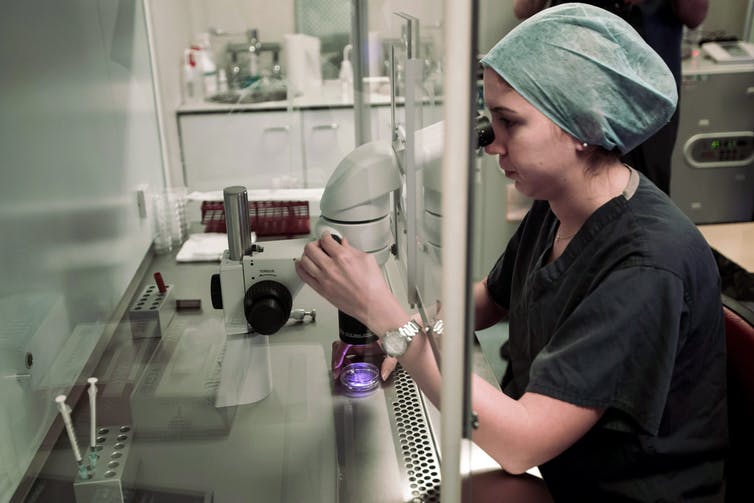Who gets the frozen embryos in the divorce?
In a recent judgment in Ontario, Canada, a court has determined that embryos can be understood as “property” and decisions about them made accordingly.
By Alana CattapanAn embryologist pulls out frozen embryos and egg cells. (Shutterstock)
This raises new concerns about decision-making related to reproductive tissues, namely that embryos may be treated like other forms of contested marital property.
In the case in question (S.H. v. D.H.), a woman wanted to use a frozen embryo that she and her ex-husband created in 2012. A single embryo remained after the woman had conceived using in vitro fertilization and given birth to a son in 2012. It was subsequently frozen and put into storage.
When the couple created the embryo, they signed a consent form stating that in case of divorce, it would be used as per the woman’s (patient’s) wishes.
The court found that, following the contract put in place by the consent form, the embryo is property that the woman can use for her own reproductive purposes.
A failure on two accounts
There are several cases in Canada in which reproductive tissue has been found to constitute property, and one case J.C.M. v. A.N.A in which frozen sperm could be divided like other marital assets. And, in 2005, a court in Alberta ruled in the case of C.C. v. A.W. — in which a man provided sperm to a friend so that she could create embryos using in vitro fertilization. After the birth of twins, the woman froze the four remaining embryos for her potential future use. Although the man did not consent to the use of the remaining embryos, the court ruled that they belonged to the woman as they were property, “chattels that can be used as she sees fit.”
Despite the similar circumstances of these cases, the decision in S.H. v. D.H. fails on two accounts.
First, it does not address the existence of regulations about consent for the use of embryos in Canada developed since C.C. v. A.W. These regulations allow for the withdrawal of consent of relevant parties up to the time that an embryo is used.
Second, it does not address the complex nature of making decisions about embryo disposition, which require consent well beyond what is decided at the time that an embryo is created.
Donor can withdraw consent
The regulations are relatively straightforward. Under Canada’s Assisted Human Reproduction Act, there are regulations about how consent for the creation and use of embryos should occur.

Under s.8(3) of the act, “no person shall make use of an in vitro embryo for any purpose unless the donor has given written consent, in accordance with the regulations, to its use for that purpose.”
And although in this case the consent forms indicate that the embryo could be used as to the woman’s wishes, the regulations state that the donor of an embryo can withdraw their consent to its use, so long as they do it in writing.
The question, then, is whether the ex-husband constitutes a donor. He does. Under Part 3 of the regulations, the donor is the “individual or individuals for whose reproductive use an in vitro embryo is created.” This includes people who are “spouses or common-law partners at the time the in vitro embryo is created, regardless of the source of the human reproductive material used to create the embryo.”
In short, if — as the court suggests — embryos are property that can be allocated like other marital assets under provincial law, the woman could have the embryo.
But in keeping with the regulations (that are part of the criminal provisions) of the Assisted Human Reproduction Act, she cannot use it for reproductive purposes without her ex-husband’s consent.
The issue of ‘buyer’s remorse’
Beyond the existence of the regulations, decisions about embryos — in the courts and otherwise — should not rely on fixed understandings of consent.
Canadian research, including my own, has found that people are often confused about their options. Decision-making about what to do with embryos happens at an emotionally charged time when people are inching closer toward their goal of having a child, and overwhelmed with the choices they are faced with as part of that process.
Further, other scholars have demonstrated that people change their minds about what to do with the embryos they’ve created over time, and that staged processes of consent may be necessary when it comes to frozen embryos in storage.
Getting consent at multiple stages is difficult — since people do not always respond to clinic requests about their embryos because they have such trouble making decision — but it is necessary. And the consent regulations of the Assisted Human Reproduction Act allow for this, in part by making explicit that consent can be withdrawn.
Towards the end of the judgment, Justice Del Frate writes that “one cannot apply buyer’s remorse” to the creation of an embryo. But therein lies the trouble. The research on decision making related to embryos suggests that one should be able to change their mind, and the regulations under the Assisted Human Reproduction Act outlines how they can.

